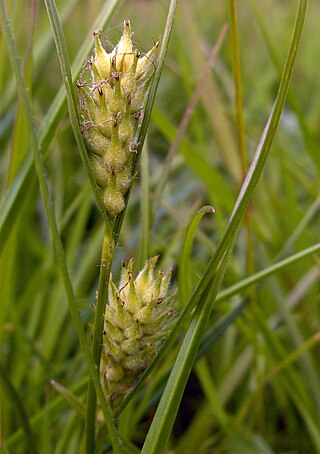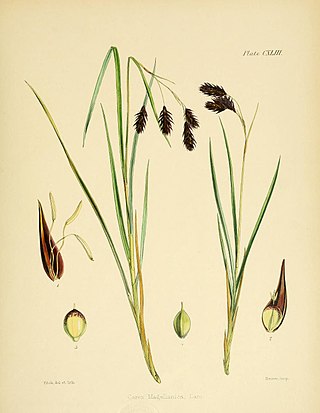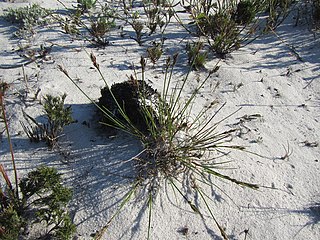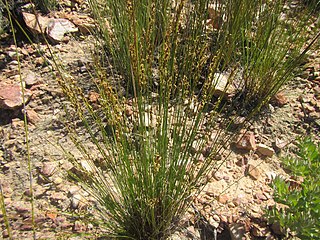
Carex is a vast genus of more than 2,000 species of grass-like plants in the family Cyperaceae, commonly known as sedges. Other members of the family Cyperaceae are also called sedges, however those of genus Carex may be called true sedges, and it is the most species-rich genus in the family. The study of Carex is known as caricology.

Lepidosperma longitudinale is commonly known as the pithy sword-sedge or pith saw-sedge. It is an evergreen species of sedge that is native to swampy areas of most Australian states. It was described by French botanist Jacques Labillardière in 1805.

Carex hirta, the hairy sedge or hammer sedge, is a species of sedge native across Europe. It has characteristic hairy leaves and inflorescences, and is the type species of the genus Carex.

Carex lacustris, known as lake sedge, is a tufted grass-like perennial of the sedge family (Cyperaceae), native to southern Canada and the northern United States. C. lacustris us an herbaceous surface-piercing plant that grows in water up to 50 cm (1.6 ft) deep, and grows 50–150 cm (1.6–4.9 ft) tall. It grows well in marshes and swampy woods of the boreal forest, along river and lake shores, in ditches, marshes, swamps, and other wetland habitat. It grows on muck, sedge peat, wet sand or silt, in filtered or full sunlight.

Carex eburnea, known as ivory sedge, ebony sedge, and bristleleaf or bristle-leaved sedge, is a small and slender sedge native to North America, from Alaska and Newfoundland south to central Mexico.

Carex texensis, the Texas sedge, is a species of flowering plant in the sedge family, Cyperaceae. It is endemic to the eastern, central, and southern United States.

Carex pumila, commonly known as strand sedge or spreading sedge, is a species of sedge of the family Cyperaceae.

Cyperus vaginatus, commonly known as stiff-leaf sedge or stiff flat-sedge, is a sedge of the family Cyperaceae that is native to Australia.

Carex magellanica, or the boreal bog sedge, is a Carex species that is native to North America. It is listed as endangered in Connecticut.

Carex brevior, known as shortbeak sedge and plains oval sedge, is a species of sedge native to North America. The specific epithet brevior means "shorter" in Latin.

Schoenus compar is a species of sedge endemic to southern South Africa.

Schoenus arenicola is a species of sedge endemic to the south-west coast of South Africa.

Schoenus auritus is a species of sedge endemic to southern and eastern South Africa.

Schoenus bolusii is a species of sedge endemic to the mountains of the Western Cape Province of South Africa. However, S. bolusii is not found on the Cape Peninsula.

Schoenus submarginalis is a species of sedge endemic to the mountains of the Western and Eastern Cape Provinces of South Africa.

Schoenus limosus is a species of sedge endemic to the KwaZulu-Natal and Eastern Cape Provinces of South Africa. It is predominantly a species of wet grasslands, which explains its common name.
Carex arctogena is a member of the sedge family (Cyperaceae) which grows in high alpine areas. It is one of the few "bipolar" species; it has populations in Greenland, Scandinavia, Russia, Canada and southern South America. Plants in the far north and south appear to be genetically identical, having taken advantage of a similar niches on opposite ends of the globe.
Eleocharis confervoides is a species of plant in the sedge family (Cyperaceae). It is a perennial, submerged, aquatic and deeply rooted herb. It is known by its common name Algal bulrush and has lots of synonyms. The species has worldwide but very spotty distribution and is native in many tropical and subtropical regions in America, Asia and Africa. It inhabits in water, usually in shallow or deep lakes and ponds. The plant has slender stem with many branches, the leaves float in the water and flowers are usually emergent over the water surface. Fruiting occurs in fall. The most occurrences of plant appear in April and frequency of occurrences is increasing the last years

Carex digitalis is a tussock-forming species of perennial sedge in the family Cyperaceae. It is native to south eastern parts of Canada as well as central and eastern parts of the United States.

Carex vestita, also commonly known as velvet sedge, is a tussock-forming species of perennial sedge in the family Cyperaceae. It is native to eastern parts of the United States.


















